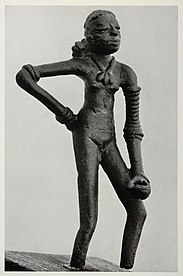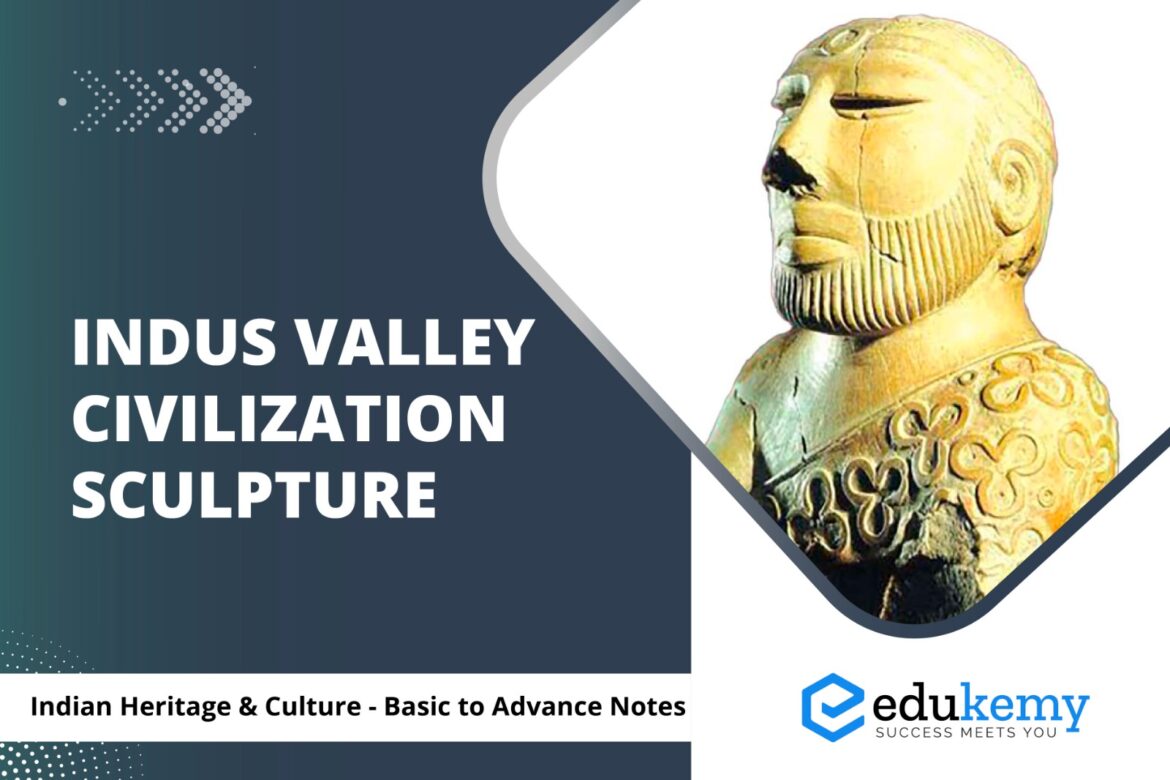
The sculpture of the Indus Valley Civilization, an ancient and advanced urban culture that flourished around 3300–1300 BCE in what is now Pakistan and northwest India, reflects the artistic achievements of a sophisticated society. While the Indus Valley Civilization is renowned for its well-planned cities and advanced drainage systems, its artistic heritage is equally notable. The sculpture from this civilization primarily comprises small, meticulously crafted figurines made of terracotta and steatite. These artifacts depict human and animal forms with a high degree of naturalism, emphasizing the civilization’s keen observation of daily life and the environment. Notable examples include the famous “Dancing Girl” and the “Priest-King,” both showcasing a remarkable level of anatomical precision. The absence of monumental sculptures or large-scale architecture suggests that the art of the Indus Valley Civilization was likely integrated into everyday life, possibly serving religious or domestic purposes. The sophistication of their sculptural techniques and the cultural insights offered by these artifacts make them crucial in understanding the complexity and creativity of one of the world’s earliest urban societies.
Contents
- 1 Dancing girl statue, Indus Valley civilization
- 2 Bust of a Bearded Man
- 3 Terracotta Sculptures
- 4 Religious and Ritualistic Use of Sculptures
- 5 FAQs
- 5.1 1. What were the main characteristics of the sculpture of the Indus Valley Civilization?
- 5.2 2. What role did art and culture play in the Indus Valley Civilization?
- 5.3 3. Were stone sculptures prominent in the art?
- 5.4 4. What are some common symbols found in the artifacts of the Indus Valley Civilization?
- 5.5 5. How did the art and symbols of the Indus Valley Civilization reflect their way of life?
- 5.6 For Admissions, talk to our Mentor – 9811333901, 9811333782
Dancing girl statue, Indus Valley civilization
The Indus Valley civilization is renowned for its art, and perhaps the most beautiful example is the statue of the Dancing Girl. Made of metal, it showcases the exceptional artistic and technical skills of the Indus Valley craftsmen. The lanky, thin figure is rhythmic, displaying the fine skills of metal casting and artistic refinement.

Curious Posture and Interesting Points
The statue’s curious posture is striking, with the figure standing in a resting pose with her right hand at her waist and her left hand on her left thigh. Although she is shown without clothes, she wears bangles on her left hand till almost her shoulder, resembling tribal people of modern-day Gujarat and Rajasthan. Additionally, her contemporary hairstyle is distinct from other mother goddess figures found in this civilization.

Monumentality of the Sculpture
Despite being just four inches tall, the statue’s monumental quality makes it unique. The artists’ accuracy in metal casting during that period is evident, making it a remarkable piece of art from the Indus Valley civilization.
Bust of a Bearded Man
Two other essential examples of sculptures from this period are the torso of a male figure in red sandstone and a bust of a bearded man in steatite.

Terracotta Sculptures
Significant examples of metal-cast sculptures have been found in Kalibangan and Daimabad. However, sculptures made from terracotta have also been discovered, including the Mother Goddess, toy carts with wheels, whistles, birds, and animals.
Religious and Ritualistic Use of Sculptures
Most of these sculptures were used for religious and ritualistic purposes, highlighting their significance in the culture and beliefs of the Indus Valley civilization. The metal casting process was also utilized for making everyday use articles like utensils.
FAQs
1. What were the main characteristics of the sculpture of the Indus Valley Civilization?
A: The sculpture of the Indus Valley Civilization is characterized by small, intricate, and often utilitarian objects made from materials like terracotta, metal, and stone. They often depict animals, humans, and abstract symbols, showcasing the civilization’s craftsmanship and attention to detail.
2. What role did art and culture play in the Indus Valley Civilization?
A: Art and culture were integral to the Indus Valley Civilization. Artifacts, pottery, and sculptures demonstrate a rich cultural heritage. The civilization had a script that remains undeciphered, but symbols and seals suggest a complex society with religious and trade aspects.
3. Were stone sculptures prominent in the art?
A: Stone sculptures were relatively less common in the art of the Indus Valley Civilization. However, when they were created, they often depicted deities or animals and were made primarily from soft stones like steatite and limestone. The most famous example is the “Priest-King” sculpture found in Mohenjo-Daro.
4. What are some common symbols found in the artifacts of the Indus Valley Civilization?
A: The artifacts of the Indus Valley Civilization are adorned with a variety of symbols, with the most famous being the “unicorn” and the “swastika.” The unicorn represents strength and virility, while the swastika is a symbol of prosperity and well-being. Other symbols include script-like markings, animals, and anthropomorphic figures.
5. How did the art and symbols of the Indus Valley Civilization reflect their way of life?
A: The art and symbols of the Indus Valley Civilization provide insights into their social, religious, and economic aspects. For example, depictions of animals suggest reverence for nature, while the unicorn and swastika symbols may indicate religious or cultural beliefs. The script-like markings on seals imply a system of communication or trade, showcasing a well-organized society.
For UPSC Prelims Resources, Click here
For Daily Updates and Study Material:
Join our Telegram Channel – Edukemy for IAS
- 1. Learn through Videos – here
- 2. Be Exam Ready by Practicing Daily MCQs – here
- 3. Daily Newsletter – Get all your Current Affairs Covered – here
- 4. Mains Answer Writing Practice – here
Visit our YouTube Channel – here

